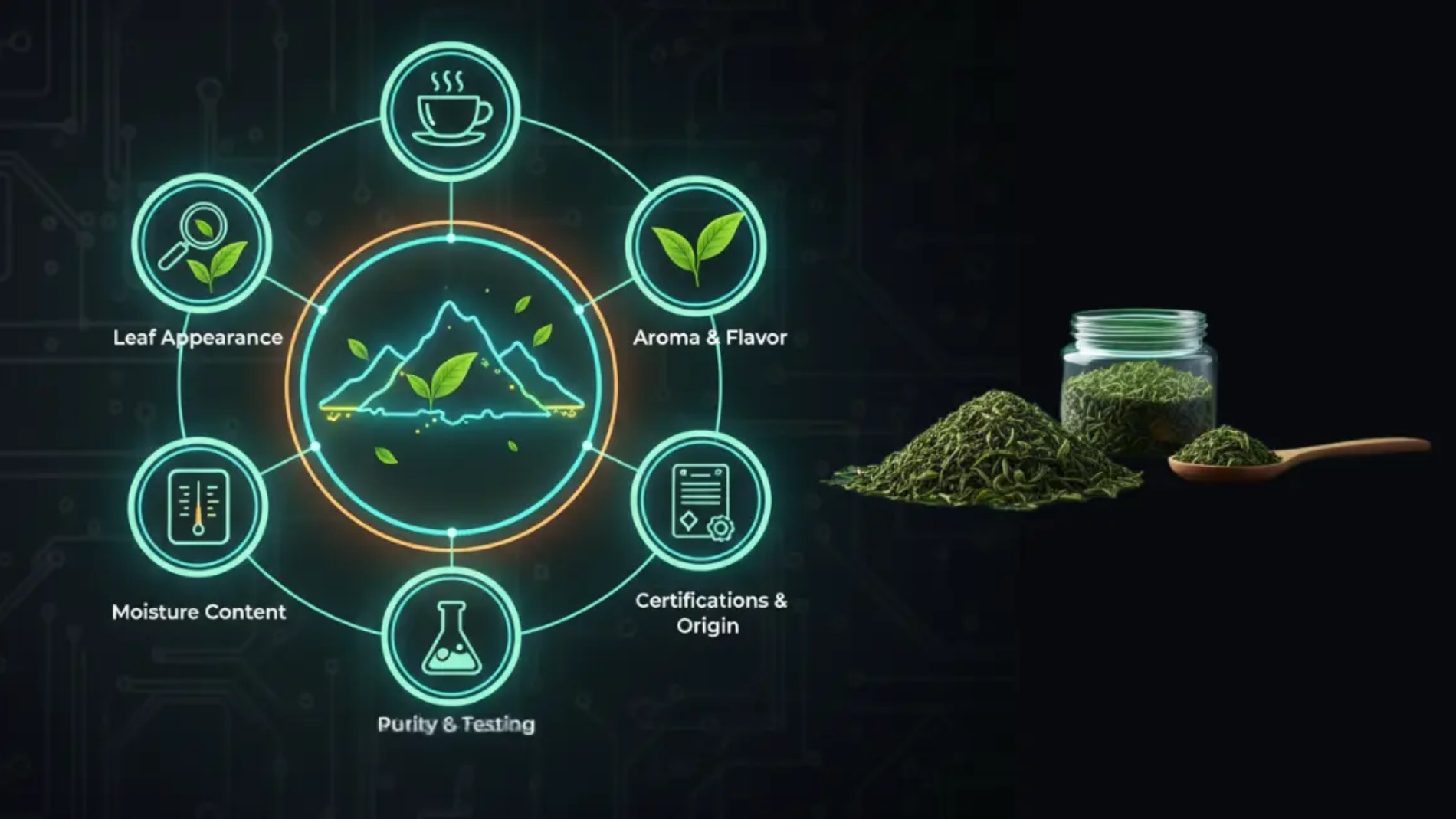In the vast world of tea, India offers a trifecta of legendary origins: the robust strength of Assam, the delicate muscatel of Darjeeling, and the fragrant, aromatic jewel of the south—Nilgiri. While it may sometimes be the quietest of the three stars, for discerning importers and specialty brands, Indian Nilgiri Green Tea represents a unique and highly sought-after profile.
Sourcing this tea successfully, however, requires looking beyond the name. It demands an understanding of the specific characteristics that define its premium quality. As an experienced exporter with deep connections in India’s tea trade, we’ve identified the five critical quality markers that every serious buyer must look for.
1. The Unmistakable Aroma: Fragrance is Paramount
The first and most defining characteristic of premium Nilgiri tea is its aroma. Unlike the grassy notes of some green teas or the malty power of Assam, a high-quality Nilgiri boasts a beautifully fragrant, floral, and often fruity bouquet.
What to look for:
A bright, lively, and intensely aromatic fragrance right out of the package.
Complex notes of flowers, tropical fruits, and a hint of sweet spice.
This exceptional aroma is a direct result of the high-altitude terroir of the tea from the Blue Mountains. If the aroma is flat, dusty, or weak, it’s a clear sign of an inferior or old product. For a brand, this fragrance is a key selling point.
Spice Up Your Business with Authentic Indian Flavors
Import and Export Excellence from India!

2. The Visual Cues: A Vibrant, Clean Appearance
Before you even brew it, the dry powder or leaf tells a story. Premium Indian Nilgiri Green Tea should be vibrant and clean in appearance.
What to look for:
For Powder: A bright, consistent green colour. A fine, uniform particle size (mesh size) is also crucial for applications like beverages, ensuring a smooth texture.
For Leaf: Well-rolled, whole or broken leaves that are uniform in size and colour.
What to avoid:
A dull, brownish, or yellowish hue. This indicates oxidation, over-processing, or old age, which means the delicate antioxidant compounds like EGCG have likely degraded.
3. The Smoothness Factor: The Low Tannin Advantage
One of the most significant commercial advantages of Nilgiri tea is that it is a naturally low tannin tea. Tannins are the polyphenolic compounds responsible for the bitterness and astringency (the dry, puckering sensation) in many teas.
What to look for:
A taste that is incredibly smooth, brisk, and clean on the palate.
A lack of a harsh, bitter aftertaste, even if slightly over-steeped.
This “forgiving” nature makes it exceptionally appealing to a broad range of consumers. It’s also the reason why Nilgiri is the number one choice for iced tea, as the low tannin content prevents the liquid from turning cloudy or “creaming down” when chilled.
4. The Origin Story: Traceability to the Blue Mountains
Authenticity is everything. True Indian Nilgiri Green Tea is grown exclusively in the high-altitude Nilgiri district of Tamil Nadu. This unique terroir, with its year-round harvest cycle, is what gives the tea its signature character.
What to look for:
A supplier who can provide clear traceability back to the specific tea estates or region within the Nilgiris.
Knowledge of the harvest seasons. While it’s a year-round crop, the teas plucked during the cool, dry winter months (our peak season, which is just around the corner) are often considered the most fragrant and flavourful.
A supplier who can speak with authority about the origin of their tea is a supplier you can trust.
Spice Up Your Business with Authentic Indian Flavors
Import and Export Excellence from India!

5. The Proof in the Paperwork: The Certificate of Analysis (COA)
For any spice importer or bulk buyer, this is the final and most critical checkpoint. A Certificate of Analysis from a third-party lab is your scientific guarantee of quality and safety.
What to look for in a COA:
Microbiological Safety: Confirmation that the tea is free from harmful bacteria, yeast, and mould.
Heavy Metal Analysis: Verification that levels of lead, arsenic, etc., are within safe limits for your target market (e.g., FDA or EU standards).
Moisture Content: A low moisture level is essential for ensuring a long and stable shelf life.
Potency (Optional but Recommended): For nutraceutical or functional food applications, a COA can also verify the total polyphenol or EGCG content.
By focusing on these five markers, you move beyond simply buying a commodity and begin sourcing a truly premium, authentic, and valuable ingredient.
Frequently Asked Questions (FAQs)
1. How does the taste of Nilgiri green tea differ from Darjeeling?
Both are delicate and aromatic, but they have distinct characters. Darjeeling often has a famous “muscatel” grape-like note and a more pronounced, prized astringency. Nilgiri is typically smoother, more fragrant with floral and fruity notes, and less astringent.
2. Why is Nilgiri tea so good for iced tea?
Its naturally low tannin content is the key. Tannins in other black and green teas bind together and precipitate when the tea is chilled, causing a cloudy or murky appearance. Nilgiri tea remains crystal clear.
3. What are tannins in tea?
Tannins are a type of polyphenol compound that contributes to the astringency and bitterness of tea. While they have antioxidant properties, high levels can be unpleasant for some palates.
4. What is the best way to brew Nilgiri green tea to appreciate its flavour?
Use water that is well below boiling (around 80°C or 176°F) and steep for only 2-3 minutes. This will extract its delicate, fragrant notes without any bitterness.
5. Is Nilgiri green tea suitable for making lattes?
While possible, its flavour is quite delicate. For a green tea latte where the flavour needs to stand up to milk, a bolder green tea like an Assam green tea is often a better choice.
6. Does Nilgiri green tea have as many health benefits as other green teas?
Yes. It is rich in the same beneficial antioxidants, particularly catechins like EGCG, that are found in all high-quality green teas and are associated with numerous health benefits.
7. Can I get certified organic Indian Nilgiri Green Tea?
Absolutely. Many estates in the Nilgiri region follow organic farming practices. Sourcing a certified organic variety is an excellent way to guarantee purity and appeal to health-conscious consumers.
8. What should I ask a potential green tea supplier?
Ask for their latest harvest samples, a batch-specific Certificate of Analysis (COA), their organic certifications, and details about the specific region or estate where the tea was grown.
About us
We bridge the gap between local producers and global markets, ensuring seamless trade facilitation with exceptional quality and reliability. We provide quick delivery services with customized packaging with all approval of International Certificates (Spices board India, MSME, IEC, fssai, FIEO, APEDA, EU certification, FDA and Many More)
Contact us
Shop No. 3, Ganesh Prestige Sr. No. 2/15, Near Laxmi Jewellers, Dhanakawadi, Pune – 411043, Maharashtra INDIA.
Call On
+91 9545205050
+91 9822422584



Leave A Comment